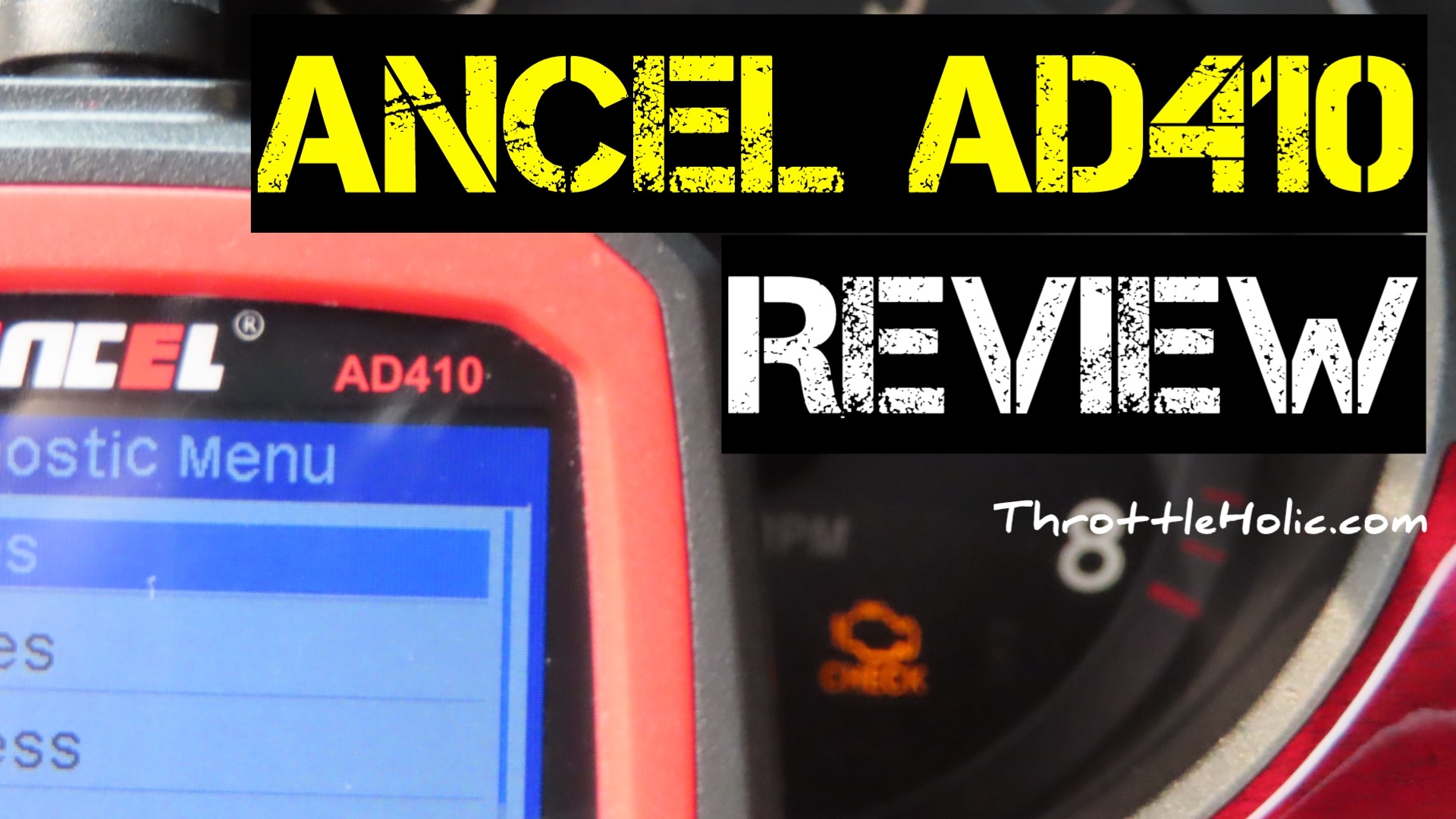The Ancel AD410 code reader is a compact, glove-box-friendly tool that promises to demystify the dreaded check engine light. In this honest review, I’ll share my personal experience with this OBD2 scanner, providing you with all the details you need to decide if it’s the right choice for you.
Throughout my years working with cars, few things are as unsettling as the sudden appearance of the ‘check engine light’ (also known as MIL or CEL). While initially alarming, this light is actually a helpful indicator, signaling potential issues and guiding you towards the problem area.
Modern vehicles are incredibly complex, packed with hundreds of parts, numerous sensors, actuators, and relays. This intricate engineering, while impressive, also means there are many potential points of failure. This is where an OBD scanner becomes invaluable. These handy, portable devices plug into your car’s OBDII port, typically located under the dashboard, and communicate with your car’s Engine Control Unit (ECU). The ECU stores diagnostic trouble codes (DTCs) that pinpoint vehicle malfunctions – a feature standard in most cars manufactured for the US market since 1996.
Professional-grade scan tools, however, can be expensive, often requiring costly subscriptions and offering features that the average car owner or DIY enthusiast will rarely need. Why invest a significant amount when a more affordable option can effectively address your primary diagnostic needs?
The Ancel AD410 OBD2 Scanner aims to be that cost-effective solution.
But the real question is: beyond the marketing claims and appealing design, how practical and effective is this OBD2 code reader? Is the Ancel AD410 a worthwhile purchase? Are there better alternatives available?
This review will walk you through everything you need to know.
Let’s start by taking a closer look at the Ancel AD410 OBD2 Scanner.
Affiliate Disclosure: Links in this article to retailers may earn me a commission if you click through and buy (at no extra cost to you). As an Amazon Associate, I earn from qualifying purchases.
Table of Contents
Ancel AD410 OBD2 Scanner Review: Initial Impressions of a Glove-Box Ready Diagnostic Tool
My first encounter with the Ancel AD410 OBD2 Scanner, over five years ago, left me with a strong initial impression: this is a well-built and robust tool.
Upon unboxing, the scanner felt substantial in my hand, suggesting durability and longevity, even with regular use. It seemed capable of withstanding accidental drops without suffering damage – though this was just a preliminary assessment at the time.
Plugging it in for the first time was a pleasant surprise. The 2.4″ color display sprang to life with vibrant clarity. This was a noticeable upgrade compared to the monochrome displays common in basic scanners of its class, both then and now.
As the device powered up, I also appreciated its ergonomic design, fitting comfortably in my hand. This positive impression remains every time I use it.
Functions & Capabilities of the Ancel AD410
When I initially purchased the Ancel AD410 OBD2 scanner, my needs were quite basic. I wanted a tool that could read and clear the check engine light (CEL), and provide a basic understanding of the issue. However, I soon discovered that the Ancel AD410 offers much more than just basic code reading. For the average car owner, DIY enthusiast, or home mechanic, this scanner is packed with impressive features, especially considering its affordable price point.
Basic OBD2 Code Reading and Clearing
For car owners who experience anxiety at the sight of the MIL illuminating on their dashboard, the Ancel AD410’s core function will be a welcome relief. This scanner allows you to quickly diagnose, address, and clear check engine light codes within minutes.
When the CEL appears, simply connect the AD410, identify the problem, perform the necessary repair, and clear the code.
Sometimes, the issue might be as simple as a loose gas cap. However, without a code reader like the Ancel AD410, determining the severity of the CEL – whether it’s a minor inconvenience or a serious problem – is impossible. The AD410 effectively addresses this concern.
DTCs Lookup Feature
The diagnostic trouble codes retrieved by the scanner often appear as cryptic alphanumeric codes, like automotive jargon. For someone not deeply familiar with OBD2 systems, deciphering a code like P0457 can be baffling.
However, the Ancel AD410 includes a built-in DTC lookup function. By simply entering the trouble code into the scanner, it provides a clear, understandable explanation: ‘Evaporative Emission System Leak Detected‘.
In many cases, this code indicates a simple issue, such as a loose or faulty gas cap. This insight allows you to address the problem quickly, often by just ensuring the gas cap is properly tightened or replacing it if necessary.
Live Data Stream Functionality
Experienced DIY mechanics understand that not every vehicle problem triggers a check engine light. Furthermore, even when the CEL is on, it often provides a general indication of a potential issue, rather than a precise diagnosis. Pinpointing the exact cause often requires more in-depth investigation, and this is where live data becomes essential.
For example, consistently negative long-term fuel trim values suggest a lean fuel mixture, potentially caused by unmetered air entering the system. This could be due to leaks in the exhaust system before the catalytic converter, or in vacuum lines. Identifying such leaks often requires a smoke test, guided by the lean condition indicated in the live data stream, even without a specific diagnostic code.
Mastering live data analysis is a crucial skill for mechanics. It’s arguably the most vital function of a scan tool, enabling diagnostics beyond basic code reading. The inclusion of this feature in a budget-friendly, basic OBD2 scanner like the Ancel AD410 is a significant advantage.
Additional Useful Features
Beyond these key functions, the Ancel AD410 OBD2 scanner includes several other features that add to its value:
First, it offers VIN retrieval, allowing you to extract the Vehicle Identification Number directly from the ECU. This is useful for verifying the VIN against the physical VIN plates on the vehicle, helping to confirm authenticity.
Second, it features an O2 sensor test. This function checks the status of the oxygen sensors and provides a report, aiding in diagnosing issues related to these critical sensors.
Third, the freeze frame function captures essential vehicle data—such as speed, engine RPM, and load—at the moment a MIL code is set. This information is invaluable for understanding the conditions that triggered the fault, especially for mechanics and advanced DIYers.
Fourth, the AD410 supports multiple languages, including Portuguese, Russian, Spanish, French, Finnish, and German, in addition to English. This broadens its usability for a diverse range of users.
Finally, it includes an EVAP system monitor test. This allows you to check the status of your vehicle’s evaporative emissions system before an official emissions test, increasing your chances of passing.
Vehicle Compatibility of Ancel AD410
The Ancel AD410 boasts broad vehicle compatibility, covering almost all vehicles manufactured in the US post-1996, as well as many major import brands.
In my personal experience, I’ve successfully used it on Lexus and Toyota vehicles. It’s also reported to work effectively with brands like BMW, Acura, Honda, Nissan, Infiniti, Kia, Hyundai, Mercedes-Benz, and most common makes on the road today.
However, compatibility with luxury sports cars and exotic vehicles has not been extensively tested. If you intend to use the AD410 on such vehicles, particularly import models, it’s advisable to verify compatibility directly with Ancel’s manufacturer support.
Limitations of the Ancel AD410 OBD2 Scanner
Before becoming too enthusiastic about the Ancel AD410, it’s important to consider its limitations, which I’ve identified through years of using the device.
Primarily a Basic OBD2 Code Reader
The Ancel AD410 is designed for beginner DIY users and those seeking basic vehicle maintenance capabilities. It’s not intended for advanced diagnostics.
For instance, if you’re experiencing transmission issues, such as rough shifting, the AD410 won’t be able to diagnose transmission-related problems as it doesn’t support transmission scanning.
Similarly, if you need to perform ABS system checks, this scanner will not be helpful, as it lacks ABS diagnostic capabilities.
Furthermore, bi-directional control, which allows you to send commands to vehicle systems to test components, is not supported by the AD410.
Small Display Screen
While the 2.4″ color display is a positive feature, its small size can be a drawback, especially for users with visual impairments or those who prefer larger displays.
However, the color display is bright and clear, offering excellent visibility despite its size. The color clarity is notably impressive for a budget scanner in this category. Seeing it in action provides a better appreciation than simply describing it – the colors are vibrant and sharp.
Alternatives to the Ancel AD410 OBD2 Scanner
The Ancel AD410 is a solid, reliable OBD2 code reader, particularly for basic engine diagnostics.
However, its functionality is limited to engine codes. For more comprehensive diagnostics, consider alternatives like the TopDon TopScan bi-directional scanner.
The TopDon TopScan, while slightly more expensive than the Ancel AD410, offers a significantly broader range of features.
It scans engine, transmission, ABS, and airbag systems, and performs numerous service functions like ABS bleeding, airbag reset, and oil resets. For its price and capabilities, the TopScan is a very competitive option.
For a detailed review, you can read my TopDon TopScan review.
If you’re looking for a basic code reader and the Ancel AD410 doesn’t quite meet your needs, the Foxwell NT301 is another excellent choice.
The Foxwell NT301 is similarly robust and user-friendly, but goes a step further by not only reading codes but also providing code definitions and step-by-step guidance for troubleshooting issues.
It’s a highly recommended code reader that offers excellent value and functionality. My detailed review of the Foxwell NT301 is available here.
Final Verdict: Should You Buy the Ancel AD410?
After more than five years of use, my Ancel AD410 OBD2 scanner, purchased around 2016-2017, remains in excellent condition, showing no signs of wear and tear despite being stored in my glove box without a protective case.
In terms of build quality and durability, the Ancel AD410 earns top marks. If you need a reliable, basic OBD2 scanner for engine diagnostics, especially one that is rugged and easy to use, the Ancel AD410 is an excellent recommendation.
However, for users requiring more advanced features, the TopDon TopScan bi-directional scanner offers exceptional value and a wider range of capabilities, particularly its bi-directional functionality and extensive features at a competitive price.
Alternatively, if you prioritize user-friendliness and guided diagnostics in a basic code reader, the Foxwell NT301 is a strong contender, offering helpful features like LED indicators for MIL status and step-by-step repair guidance.
Enjoyed This Review? Subscribe for More Auto DIY Content!
Throttle Lan
DIY Mechanic and Freelance Auto Writer
I’ve been working on cars for about five years now. If it has an engine, I’m confident I can get it running, regardless of its complexity. When I’m not fixing cars, I enjoy writing about the process and sharing my knowledge.

